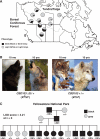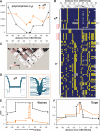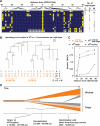Molecular and evolutionary history of melanism in North American gray wolves
- PMID: 19197024
- PMCID: PMC2903542
- DOI: 10.1126/science.1165448
Molecular and evolutionary history of melanism in North American gray wolves
Abstract
Morphological diversity within closely related species is an essential aspect of evolution and adaptation. Mutations in the Melanocortin 1 receptor (Mc1r) gene contribute to pigmentary diversity in natural populations of fish, birds, and many mammals. However, melanism in the gray wolf, Canis lupus, is caused by a different melanocortin pathway component, the K locus, that encodes a beta-defensin protein that acts as an alternative ligand for Mc1r. We show that the melanistic K locus mutation in North American wolves derives from past hybridization with domestic dogs, has risen to high frequency in forested habitats, and exhibits a molecular signature of positive selection. The same mutation also causes melanism in the coyote, Canis latrans, and in Italian gray wolves, and hence our results demonstrate how traits selected in domesticated species can influence the morphological diversity of their wild relatives.
Figures



Comment in
-
White wolves can stand the heat.Science. 2009 May 29;324(5931):1141-3. doi: 10.1126/science.324_1141b. Science. 2009. PMID: 19478165 No abstract available.
-
How the gray wolf got its color.Science. 2009 Jul 3;325(5936):33-4; author reply 34. doi: 10.1126/science.325_33. Science. 2009. PMID: 19574371 No abstract available.
References
-
- Gipson PS, et al. Wildl. Soc. Bull. 2002;30:821.
-
- Mech LD, Adams LG, Meier TJ, Burch JW, Dale BW. The Wolves of Denali. Univ. of Minnesota Press; Minneapolis, MN: 1998.
-
- Peterson RO, Wollington JD, Bailey TN. Wildl. Monogr. 1984;88:3.
-
- Musiani M, et al. Mol. Ecol. 2007;16:4149. - PubMed
-
- Jolicoeur P. Evolution. 1959;13:283.
Publication types
MeSH terms
Substances
Associated data
- Actions
- Actions
- Actions
- Actions
- Actions
- Actions
- Actions
- Actions
Grants and funding
LinkOut - more resources
Full Text Sources
Other Literature Sources
Miscellaneous

